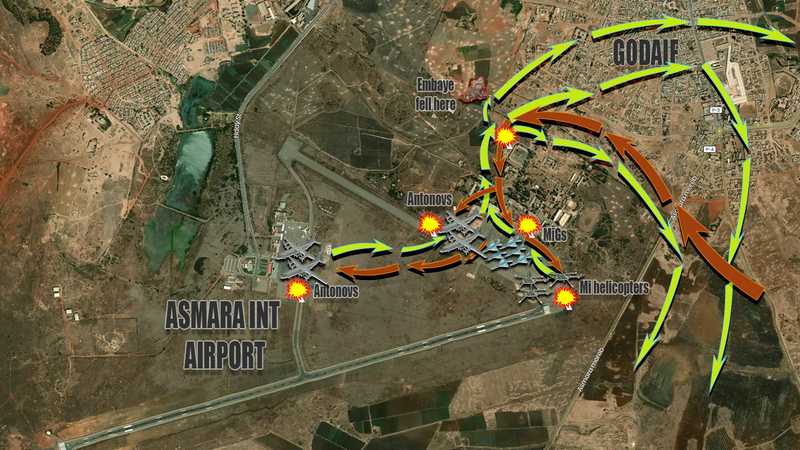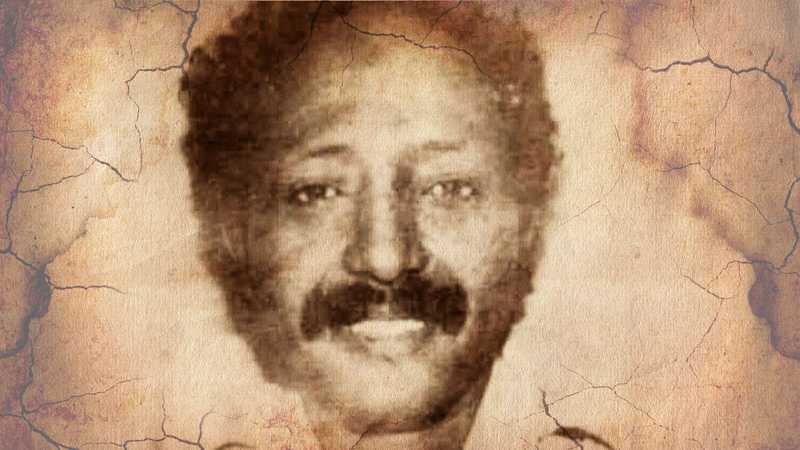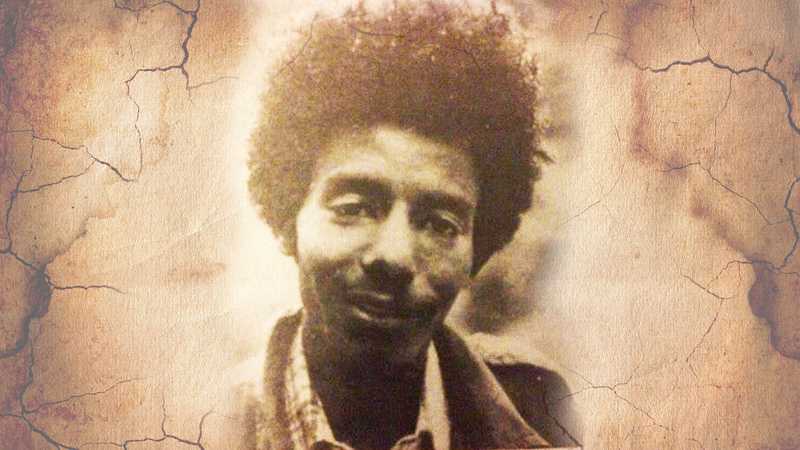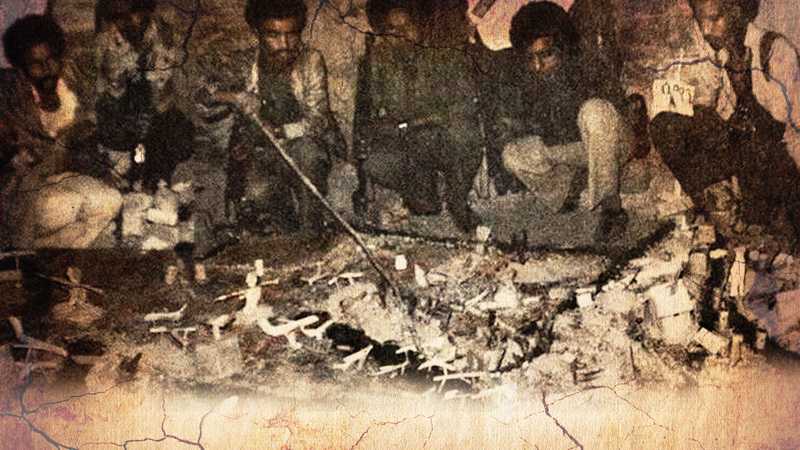EPLF Commando 18 Minute Operation at Asmara Air Force Base
21 May, 1984
33 military aircraft were destroyed in 18 minutes by elite EPLF commando unit at the Ethiopian Air Force base at Asmara Airport.
 The plan of the EPLF commando attack on Asmara Air Force base in 1984, the 18 minute wonder
The plan of the EPLF commando attack on Asmara Air Force base in 1984, the 18 minute wonder
At least 30 military aircraft were destroyed in 18 minutes by an elite EPLF commando unit at the Ethiopian Air Force base near Asmara Airport. This operation, remembered with awe by many Eritreans as “The 18 Minute Wonder,” was the culmination of an extended period of intelligence gathering, planning and execution. Many heroic Eritrean tegadelti and civilian operatives in the vicinity of Asmara gave their time, property and their personal safety with some paying the ultimate sacrifice, giving their lives for the operation. The operation sent shock waves through out the Dergue government and all their allies.
Ibrahim Afa, a senior military commander in EPLF, stressed to the commandos that completed the intensive training that what they were about to undertake was significant not only militarily, but politically. The fact that the operation was to be carried out at the hub of Ethiopian Air Force in Eritrea, in the Asmara Air Force base, would deal a significant blow to the Ethiopian Dergue government while showing the rest of the world that the armed struggle for Eritrean independence is alive and kicking, especially in the aftermath of the Ethiopian Red Star campaign and the 6th offensive of 1982, that was launched to wipe out the struggle “once and for all.”
 Ibrahim Afa, senior military commander in EPLF
Ibrahim Afa, senior military commander in EPLF
The Ethiopian government had always the unfair advantage of the air force against the EPLF fighters. It carried out non-stop sorties to the frontlines and also to home bases of the EPLF in the mountains of Sahel. Freedom fighters had attempted to carry out similar sting operations prior to this one beginning from the ELF days. It can be said none of them was at this scale and had not involved as many military personnel and civilian covert agents.
A long detailed intelligence gathering operation was carried out way ahead of the attack. Many village and city dwellers collected intelligence from within the city of Asmara, at a great risk to themselves, their comrades and their families and passed it to EPLF. Some were even working within the facilities of the air force to provide some of the most crucial details. Couriers would meet with EPLF freedom fighters in the villages surrounding the city. Crucial materials and weapons would be brought in and stashed away in safe houses at different locations within the surrounding villages and even within the city limits. Some were hidden in underground holes, or in roofs and even at one point, walled off under a ne’edi, a mud and stone bed-like platform in the very dwelling spaces of a typical highland village household.
From time to time, senior commanders would travel south, all the way from Sahel, to closely monitor developments, to meet with agents and eventually to coordinate the attack. One of such commanders was Sebhat Efrem, a.k.a. Wedi Efrem, who oversaw the operation.
 Sebhat Efrem, senior military commander in EPLF
Sebhat Efrem, senior military commander in EPLF
Once all the intelligence was gathered and a strategy was developed on how to approach the Air Force base, it was crucial to have the most time-sensitive and most recent intelligence within the base. To accomplish this, two agents, Mehreteab Gebre and Michael Gide Megos, were able to get in to the airport with a help of two other recruits, one that provided a car and another access to the higher floors of Asmara Airport from where the air force base could be closely observed and studied. From there, they were able to gather intelligence on:
- the number and types of aircraft present,
- enemy defensive positions,
- distance and proximity of assets,
- enemy watch/guard posts,
- breadth and height of fences and barbed wires
Not only was the above significant but it also was crucial in confirming previously gathered information which had been obtained from a relatively further proximity.
A sand model was constructed in a unassuming hut somewhere in the vicinity of Ala where all operation briefing and preparation was made.
 EPLF commando planning the attack on Asmara Airforce base on sand model in 1984
EPLF commando planning the attack on Asmara Airforce base on sand model in 1984
Once all the intelligence was gathered and a plan of attack was set, the commando unit set out of Ala and walked all night and arrived in the Mai Habar area at dawn on May 10, 1984 and they stayed in an underground holding place at Aboy Haile Feqadu’s house. There they made further preparations such as switching their leather made war belts to those made of canvas, sorted their ammunition especially the incendiary ones which would be used to burn enemy assets. They were given military clothes, camouflaged for the operation, but also were given denim pants and t-shirts to wear under the tactical clothes. This was done just in case they have to mingle with civilians after the operation until they get to safety. The square-toed Asmara plastic shoes were also specifically ordered for the operation as what the fighters wore were identifiably different. They stayed there until the 19th.
On the 19th, a heifer calf was slaughtered for them and were fed before they set out to scale the hilly escarpments to reach Tselot where a safe house was prepared for them at the house of Aboy GilaEgzi’e. Their guides were Tekeste Gilaegzi’e, Aboy Gilaegzi’e’s son, and Kifle Gebray. They were fully armed as they trekked on foot. They arrived at 9PM in the evening and were to stay there until the time of the operation on the morning hours of the 21st. That meant they would not leave the house, more like a room rather, for almost 24 hours.
A very challenging and quite notable conundrum occurred at the house; one perpetrated by nature. One of the commandos, Wedi Ammar, was really badly bloated and helplessly needed to relieve himself. These houses do not even have detached outhouses; village folks have to walk to the outskirts of their hamlets to address such natural needs. The rest of the team tried everything but to no avail. They tried to hold a sheet around him but he could not bring himself to do it. This became a big problem that could possibly jeopardize the whole operation. After weighing different options, they decided to dress him up as an elderly lady. They put him in Adey Tserha’s dress who was taller than Qeddish, Tekeste the guide’s wife, and he would walk outside with Qeddish. He had to walk like an elderly mother walking with her daughter. He did successfully.
At 8PM, they were split into two groups: ሀ [A] and ለ [B]. Two scouts, Tekie and Asmelash, were sent to Asmara to do final assessment before the operation and they were told to rendezvous at the dam at Merhano to brief the commando units and guide them into Asmara to the place where from they were supposed to launch their attack. But for some reason, they could not meet at the site. Later on, the scouts had said they had come to the site but possibly in a different side of the dam. This was quite worrisome and could derail the operation. Because it could have meant that the scouts were caught; or entry and exit points into the city could have been blocked. But the commander of the operation, Mehreteab Gebre a.k.a. Isaias, decided to carry on with the operation irrespective of the concerning situation.
Isaias replaced the missing guides with Kuhil and Goitom. He assigned Wedi RegaHit to lead the commandos to where the MiG fighters were, Kuhil to the entry point on the barbed-wire fence and Goitom to the area where the tanks were parked a.k.a. enda Hasser. Here is the full list of how the commandoes were teamed up and what each team’s targets were:
-
Mehreteab Gebre a.k.a. Isaias - Commander (weapons: Pistol with silencer)
-
First Team (Target: Jet Fuel depot and Civil Aviation Authority )
- Hadgu Wedi Hryti - Second in Command of the operation (weapons: Kalashnikov)
- Mekonnen Yhdego a.k.a. Nebelbal (weapons: Rocket Propelled Grenade, RPG)
-
Second Team (Target: Antonov and light bombers)
- Semere Wedi Rishan (weapons: RPG)
- Teklebrhan Wedi Qeshi (weapons: Rocket Propelled Grenade, RPG)
-
Third Team (Target: MiGs and Helicopters )
- Seele/Aregay (weapons: RPG)
- Aynealem a.k.a. Ma’anTa (weapons: Kalashnikov)
-
Fourth Team (Target: MiGs )
- Mehari Wedi Margano (weapons: RPG)
- Hayelom/Asrat (weapons: Kalashnikov)
-
Fifth Team (Target: MiGs and Helicopters )
- Gebrehiwot a.k.a. Qsun (weapons: RPG)
- Demoz Girmatsion (weapons: Kalashnikov)
-
Sixth Team (Target: MiGs and Helicopters )
- Tsegay/Tekeste (weapons: RPG)
- Mebrahtu Wedi RegaHit a.k.a. Embaye (weapons: Kalashnikov)
-
Lookouts at the barbed-wire fence exit
- Yemane Hdat a.k.a. QuHil (weapons: Kalashnikov, pistol with a silencer)
- Fitsum Wedi Ammar (weapons: Kalashnikov)
-
Lookout at tanks area or enda Hasser
- Goitom/Solomon Abraha (weapons: Kalashnikov)
They set out from Merhano Dam and arrived at the Godaif check point in Asmara. There was an amphibian patrolling the area but Isaias and Wedi Hryti managed to cut through the barbed-wire fence with no difficulty. They let the rest in.
It was Sunday evening and the soldiers were in leisure time and so could not hear the commandos. Right when all the commandos got to their designated places, a guard in the MiGs section saw Wedi Margano and cried out to bring attention. Wedi Margano fired his RPG at that very moment hitting a MiG jet fighter along with the guard. That signaled the beginning of the operation. All the fighters started hitting their targets and the air force grounds shook with explosions and rising fireballs. RPG rockets were flying while incendiary bullets started to whiz by crisscrossing the airfield. Fire engine sirens started to wail in the commotion.
People in Asmara could hear all the noise that was coming from the direction of the airport. Many opened their windows to listen in. It was clear that it was an attack by the freedom fighters. They couldn’t wait until the morning to listen to the Voice of the Masses radio program which was broadcast in early mornings from the mountains of Sahel; they needed to know what exactly all the explosions meant.
The darkness of the night helped the commandoes tremendously for the sting operation. At some point however, when the arms depot was hit, a incendiary bomb exploded lighting up the darkness as it burned violently. With the soldiers starting to take their positions, it became quite chaotic for the commandoes and they started to be separated from each other. Some had to abandon their designated exit points and had to cut through the barbed-wire fences somewhere else.
Isaias, Wedi Rishan, Aynalem Ma’anta and Goitom managed to get out through the planned exit point after facing a guard that tried to stop them. Isaias spoke to the guard in Amharic, pretending to be a friendly. Once he got close enough to him, he used his pistol with silencer to kill him. They all left together, trekked through QeHawta, then Embeyto to eventually join their comrades at Adi Qeshi.
Wedi Hryti managed to get out in the morning around 7AM. Mebrahtu Wedi RegaHit however was hit from the side when he was cutting through a barbed-wire. He fell. He was still alive but he was not going to fall into enemy hands; he used his own grenade on himself and heroically died there. Mengistu Hailemariam, the head of the military Dergue and the president of the Ethiopia, is said to have scolded his soldiers that were mistreating the body of the fallen fighter. To their shame, he told them to honorably bury him because he was a hero to have died for what he believed in.
Wedi Margano, Hayal, Tekeste, Tekleberhan Wedi Qeshi, Gebrehiwot Qsun were lost and ended up in Tselot. Being met with enemy fire there, they wandered off further into GuleI. Through the help of villagers, they managed to finally join their comrades 3 days later after remaining hidden in the area.
So out of 16 commandos, 15 made it out. One fell heroically. 33 aircraft plus arms and fuel depots were burned to the ground.
The Ethiopian army thought it was a large scale operation with confusion of the night and the spread of the explosions. Other EPLF units were also firing artillery in the general direction of the airport to cause diversion. So there was no counter offensive from the Ethiopian army as they could not pinpoint the exact origin of the attack.
